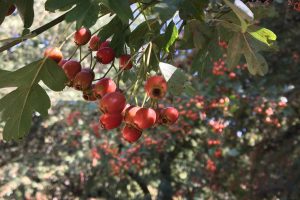Trees to See!


Coral Bark Japanese Maple
Translated to “coral pillars” or “coral tower”, the bark of ‘Sango Kaku’ Japanese Maples turns reddish-pink in the winter months; however, this upright variety is a tree of all seasons! Autumn transforms the bright green leaves of the Summer season to golden yellow and orange; and as the weather gets colder, the color intensifies and transforms the winter landscape with its stunning salmon colored bark.
Location: Northern picnic area on Bristlecone Pine Trail


Common Snowberry
Although the pink and white flowers of this shrub are not too showy, the fruit of the common snowberry is sure to get your attention wherever you may find it. Easy to identify, just look for the tight clusters of large, snow white drupes. This plant gets its various common names from its fruit; also known as corpse berry, perhaps for their ghostly color, or waxberry, with their waxy finish.
Location: Planting areas around Stevens Pavilion
Crape myrtle, a popular ornamental tree, is known for its showy summer flowers and attractive winter bark. Somewhat crinkled (like crepe paper!), the flowers bloom in red, pink, purple, and white, with every shade in between. Crape myrtle can be in bloom for up to four months, making it one of the longest blooming trees on the continent! During the winter, this tree’s bark exfoliates and reveals a beautiful patchwork of multicolored inner bark of brown, gray, and tan.
Location: Visitor Center courtyard
A member of the Rose family, Hawthorns bear small pomes, the same fruit type as apples and pears! With most ripening in autumn, the red fruit will remain on the branches throughout the winter. Look for the remains of the sepals, stamen, and styles on the opposite side of the stem!
Location: Hawthorn Trail
Stay Up-To-Date with Hoyt Arboretum!
Subscribe to our email newsletter
AND


